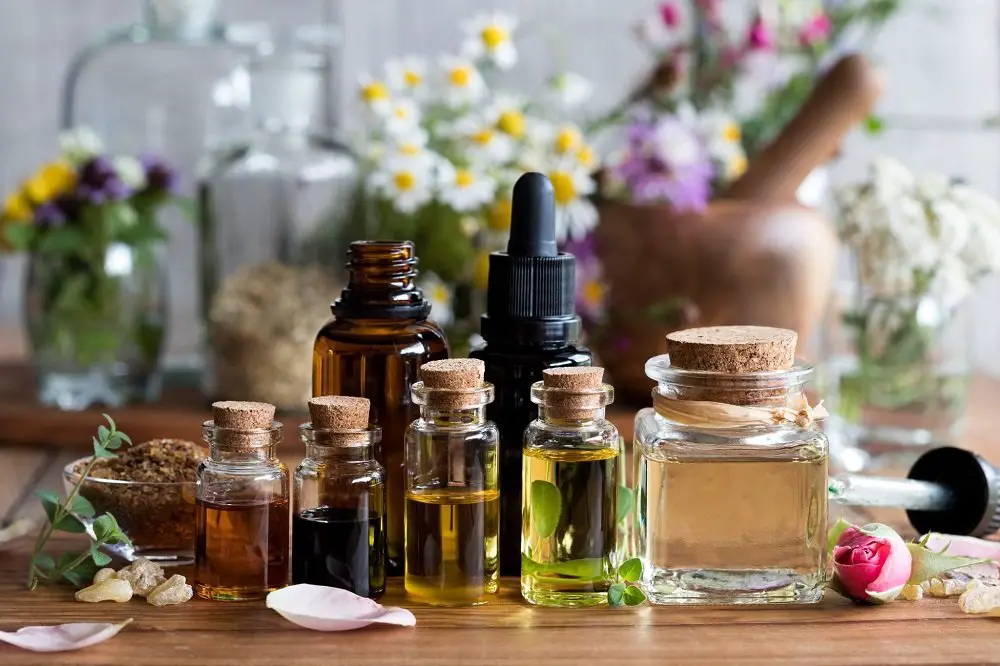When you’re just beginning to learn essential oil blending, or you’re self-taught and looking to expand your vocabulary, carrier oils are crucial to understanding. What’s the big difference anyway? Do you need a carrier oil? Which ones are the best? It can seem a little overwhelming at first. No worries though, I’ll explain everything you need to know to make perfect oils for every occasion. Whether you’re creating a perfume, mixing for aromatherapy and health, or even DIYing some bug spray, terminology matters. Fortunately, it’s not tough to master this critical difference. With a few facts and some inspired blending, you’ll be creating superb essential oils in no time. If you have the nose for it, mixing your own scents is very rewarding. You’ll get more than you bargained for with a suitable carrier, and your other oils will go much further.
What is the difference between essential oils and carrier oils? A carrier oil is neutral, with little to no scent, while essential oils are highly scented. Moreover, essential oils are often too potent for a topical application alone. Thus you need to dilute the essential oil in a carrier oil to use it safely and effectively.
Why You Need a Carrier Oil
Carrier oils live up to their name by quite literally carrying an essential oil for topical application. These neutral, odor-free, or very mild plant-based oils are ideal for making the most of your aromatics, and safe use.
Typically carriers come from the nuts, kernels, or seeds of a plant. Good examples are coconut oil or sweet almond oils. Not all carrier oils are edible, though some certainly are because nut oils are frequently edible for humans.
A few carrier oils come from flowers. However, this is far less common. Evening primrose oil is a common carrier. It’s mild on skin and may help with eczema or other skin conditions, which is rare for an oil.
For those who want to experiment a bit, the Premium Nature Carrier Oils For Essential Oil five pack is an excellent place to start. You get four ounces each of avocado, sweet almond, coconut, castor, and grapeseed oils. Blend your own massage oils, skin care products, and more. Learn more on Amazon by clicking here.
Common Carrier Oils
While you can undoubtedly use other carrier oils, the ones on this curated last are the most common. I’ve listed their names and scientific names along with what they work best in conjunction with to help you make ideal blends with your essential oils. Whatever you want to do with aromatics, there’s a carrier oil for that.
- Coconut (Cocus Nucifera)- Coconut oil has a natural smell, just like coconut water and meat. However, you can also easily find unscented coconut oil if you prefer it. Coconut makes an excellent skin treatment, lip balm, or massage oil. Moreover, coconut goes well in oil burners to help create an aromatic ambiance in your home. Additionally, you can warm it up to turn coconut oil from thick and creamy to a more liquid consistency.
- Black Cumin Seed (Nigella Sativa)- Black Cumin oil is a lightly scented earthy golden oil. Use this option if you’re creating a healing blend for wounds or skin conditions. The antifungal, antibacterial, and anti-inflammatory properties are excellent in joint rubs, massage, and even blended with tea tree oil for toenail fungus.
- Evening primrose oil (Oenothera Biennis)- Arguably, the most delicate of all the carrier oils, evening primrose goes rancid quickly and is best kept in cold conditions. You can even put it in the refrigerator between uses. Choose this valuable oil for aromatherapy blends like those in a diffuser. The additional light and sweet smell is a pretty addition to florals, citrus or musk, but doesn’t go as well with savory or minty essential oils in general.
- Grapeseed oil (Vitus Vinifera)- You may already have grapeseed oil in your kitchen for cooking. Though this nearly clear, lightly nutty oil makes tasty food, it is also a great neutral for most applications. As all-purpose carriers go, this is a great go-to choice.
- Jojoba oil (Simmondsia Chinensis)- Jojoba oil is a waxy substance that is surprisingly good for oily and acne-prone skin. Use this for massage, skin treatments, and sensitive skin. The unique scent is instantly recognizable but also pleasant and not overpowering. Furthermore, you can use this carrier oil with or without essential oils in making shampoos, conditioners, and skincare products.
- Rosehip oil (Rosa Mosqueta)- A natural source of vitamins E and C, rosehip oil is anti-inflammatory. Use this for massage or skincare products, but don’t waste it inside diffusers as you won’t get the full benefit.
- Sweet Almond (Prunus dulcis)- Among the most commonly used carrier oils is sweet almond. Both sweet almond and regular almond oils make outstanding neutral options for perfumes and skincare. The benefits of almond oil include reducing bags under eyes, moisturizing skin, and it diminishes both sun damage and scars. Please note that people with nut allergies should not use almond or other nut-based oils.
These are by no means the only carrier oils available. Tamanu, hemp, sunflower, apricot seed, argan, and avocado carrier oils are also popular, plus there are plenty of others as well. Feel free to experiment with your oils to get the exact result you want.
For a considerable variety of carrier oils, try out Fabulous Frannie’s Pure Carrier Oil Variety Pack from Amazon. With twelve leading carriers to choose from, you can blend to your heart’s desire. This trusted brand will surprise you pleasantly. Have them delivered to your door when you order here.
Oil Storage
Most carrier oils last six months to two years at most. Additionally, because carrier oils have natural fats, they can become rancid quite quickly if improperly stored. I always recommend keeping oils inside dark brown glass containers.
Unlike plastics, neither the glass nor the oils will affect each other. Moreover, glass doesn’t allow for a slow exchange of oxygen like plastics do, and it does not photodegrade in sunlight. Speaking of sunshine, keep your oils away from the sun and other bright light sources when not in use.
All oils should be kept at or below room temperature. Though there are dissenting opinions, I often suggest a cooler environment like the refrigerator for carrier oil storage. Finally, keep your oils in sealed bottles and away from sources of moisture and contamination.
Essential Oils Can Be Volatile
Essential oils come from plants. Specifically, they are distilled using roots, leaves, flowers, or even the bark. Some get cold-pressed while others are removed using a steam process.
Because these plants vary in their potency, the strength of your oils depends on where and how they’re grown. Weather, soil, and the method used to extract the oil also affect the end result. It is vital to invest in high-quality oils from companies that have testing standards. Otherwise, you may end up with subpar essential oil.
Essential oils evaporate over time. Undoubtedly disappear much more quickly. Another advantage of using a carrier oil is that these typically do not evaporate quickly because of their viscosity. Resultantly, your essential oil suspended within will remain fragrant and usable for much longer.
More importantly, some plant oils are so robust that they can cause chemical burns if placed directly on the skin. Additionally, the volatility and flammability of oils can vary extensively. Hence you need an excellent carrier for safety.
Ratios & Blending
Basic blending guidelines are surprisingly simple. As you learn and progress, you may find that these always work for you, or you may toss them out entirely in favor of your own proportions. However, the basics break down simply.
For skincare products, the ratio of essential oil should be about two percent. In other words, two drops of essential oil per hundred drops of the carrier. Alternately, perfumes can be as high as five percent, or one drop of essential oil in every twenty drops of the carrier.
Diffusers don’t require a carrier oil. However, your essential oils will go a lot further if you use them. A much higher ratio works well here, about one to two drops of essential oil for every ten drops of the carrier. Moreover, using carrier oil can help prevent your diffuser from creating an overwhelming aroma in a small space.
Get a collection of three outstanding high-quality carriers; I recommend the Now Foods Variety Moisturizing Oils Sampler. These fatty oils are all exceptional for skincare, massage, and perfumes. Use Avocado, Jojoba, and Almond to make the best blend for your needs anytime. See the ratings for yourself by clicking here.
Final Thoughts
Using essential oils and carrier oils, you can make almost any scent you can imagine and many more as well. Have you ever wanted to re-create a favorite scent so you can wear it, or make your home smell exactly like your favorite pastry? It’s exciting to make custom mixtures.
Play around with different ingredients and get creative. Also, keep in mind that, on people, body chemistry affects the way a given blend will smell. There’s plenty of challenge and reward in learning to use carrier oils correctly.
Whether you want to decrease the volatility of essential oil, or made it go a whole lot further, you have taken the first step. Now, take your newfound knowledge and use it to make your olfactory dreams come true.

